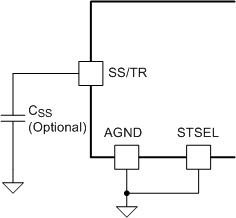ZHCSBC7E JULY 2013 – December 2019 LMZ31710
PRODUCTION DATA.
- 1 特性
- 2 应用
- 3 说明
- 4 修订历史记录
- 5 Pin Configuration and Functions
- 6 Specifications
-
7 Detailed Description
- 7.1 Overview
- 7.2 Functional Block Diagram
- 7.3
Feature Description
- 7.3.1 VIN and PVIN Input Voltage
- 7.3.2 3.3-V PVIN Operation
- 7.3.3 Adjusting the Output Voltage (0.6 V to 5.5 V)
- 7.3.4 Capacitor Recommendations For the LMZ31710 Power Supply
- 7.3.5 Transient Response
- 7.3.6 Power Good (PWRGD)
- 7.3.7 Light Load Efficiency (LLE)
- 7.3.8 SYNC_OUT
- 7.3.9 Parallel Operation
- 7.3.10 Power-Up Characteristics
- 7.3.11 Pre-Biased Start-Up
- 7.3.12 Remote Sense
- 7.3.13 Thermal Shutdown
- 7.3.14 Output On/Off Inhibit (INH)
- 7.3.15 Slow Start (SS/TR)
- 7.3.16 Overcurrent Protection
- 7.3.17 Synchronization (CLK)
- 7.3.18 Sequencing (SS/TR)
- 7.4 Device Functional Modes
- 8 Application and Implementation
- 9 Power Supply Recommendations
- 10Layout
- 11器件和文档支持
- 12机械、封装和可订购信息
7.3.15 Slow Start (SS/TR)
Connecting the STSEL pin to AGND and leaving SS/TR pin open enables the internal SS capacitor with a slow start interval of approximately 1.2 ms. Adding additional capacitance between the SS pin and AGND increases the slow start time. Increasing the slow start time will reduce inrush current seen by the input source and reduce the current seen by the device when charging the output capacitors. To avoid the activation of current limit and ensure proper start-up, the SS capacitor may need to be increased when operating near the maximum output capacitance limit.
Table 6 shows an additional SS capacitor connected to the SS/TR pin and the STSEL pin connected to AGND. See Table 6 for SS capacitor values and timing interval.
 Figure 29. Slow-Start Capacitor (CSS) And STSEL Connection
Figure 29. Slow-Start Capacitor (CSS) And STSEL Connection Table 6. Slow-Start Capacitor Values And Slow-Start Time
| CSS (nF) | OPEN | 3.3 | 4.7 | 10 | 15 | 22 | 33 |
|---|---|---|---|---|---|---|---|
| SS Time (msec) | 1.2 | 2.1 | 2.5 | 3.8 | 5.1 | 7.0 | 9.8 |